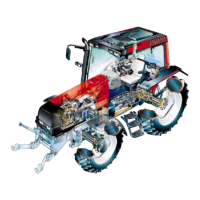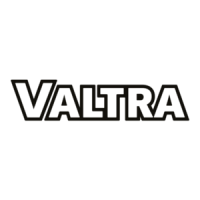12
Model Code Page
12. Repairs
8. 11. 1990
6000--8750 120 2
Handling of he avy components
Unless otherwise specified, all removals should be accom-
plished using adjustable lifting equipment. All supporting
slings must be parallel to each other and as near vertical as
possible in relation to the object being lifted. However, where
slings are of a far greater capacity than the weight of t he load
to be fitted, a triangular lifting arrangement may be used.
Oikein
Rätt
Right
Richtig
Giusto
Väärin
Fel
Wrong
Falsch
Sbagliato
Correct
Teisingai
Mauvais
Netei-
singai
When removing a component at an angle, remember that the
capacity of an eyeboltis reduced when the angle between the
supporting members and the object becomes less than 90˚.
B
C
D
A
Forged eyebolt support
A. Load
B. Lifting shackle
C. Shackle retaining plate ( 3 mm thick)
D. Sleeve
When necessary the forged eyebolt can be supported in the
way shown in figure above. Sleeve D may or may not be
welded to plate.
Warning! If a part resists removal, check that allnuts and bolts
have been removed and that there is no interferenc e from ad-
jacent parts.
Cleanliness
To ensure long life of a machine, it is important tokeep dirt and
foreign material out of its vital working components. Precau-
tions must be taken to safeguard against this. Enclosed com-
partments, seals and filters have been provided to keep the
supply of air, fuel and lubricant clean. These protective de-
vices must not be removed.
Whenever hydraulic, fuel, lubricating oil or lines are discon-
nected, clean the point of disconnection and the surrounding
area. As s oon as a line has been disconnected, cap, plug or
tape the line or opening to prevent the ingress of foreign ma-
terial.
The same cleaning and covering precautionsshouldbe taken
when access co vers or inspection plates are removed.
Clean and inspect all parts. Make sure that all passages and
holes are clear. Cover all parts to keep them clean. Make sure
parts are clean when they are reassembled. Leave new parts
in their wrapping until they are actuallyneeded for reassembly
Assembly
When reassembling a machine, complete each step in se-
quence. never partially assemble one part then start to as-
semble another. Make all recommended adjustments. Al -
ways check the job on completion to ensure that nothing has
been overlooked. Recheck the various adjustments before
putting the machine back into service.
Note! Before fitting new parts, remove rust preventative com-
pound from all machined surfaces (usually ”peel---off sub-
stances).
Lubrication
Where applicable, fill the compartments of repaired or re-
newed components with the quantity, type and grade of clean
lubricantrecommended in the routinemaintenance section of
the Operator’s Manual.
Shims
When shims are removed, tie them together and identify their
locat i on. Keep shims clean and take care not to bend them
before refitting them.
Gaskets
Make sure that the holes in gaskets line up with lubricating oil
passages in the mating parts. If gaskets have to be made, use
material of the correct type and thickness. Make sure that
holes are punched in the right places.
Incorrectly punched gaskets can cause serious damage.
Lip type rubber seals
Lubricate the lips of lip---type rubber seals with oil before fit-
ment. Do not use grease on seals, except for grease seals.
https://www.truck-manuals.net/

